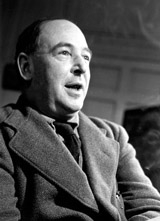Stealing past those watchful dragons…

The answer was “no.” C. S. Lewis could not write “directly theological pieces” for Christianity Today. His days of writing straightforward apologetics were over, as he explained in response to a request from editor Carl F. H. Henry in 1955.
I wish your project heartily well, but can’t write you articles. My thought and talent (such as they are) now flow in different, though I trust not less Christian, channels, and I do not think I am at all likely to write more directly theological pieces . . . If I am now good for any thing it is for catching the reader unawares – thro’ fiction and symbol. I have done what I could in the way of frontal attacks, but I now feel quite sure those days are over.
Lewis’s reason was strategic—the times had changed and, for his part, a new approach was required. He would no longer pursue the “frontal attack” of his previous books and essays.
But supposing that by casting all these things into an imaginary world, stripping them of their stained-glass and Sunday school associations, one could make them for the first time appear in their real potency? Could one not thus steal past those watchful dragons?
Lewis’s explanation of “stealing past watchful dragons” by using fairy tales appeared in a 1956 article entitled “Sometimes Fairy Stories May Say Best What’s To Be Said,” the same year that the inaugural issue of Christianity Today was published.
Some people seem to think that I began by asking myself how I could say something about Christianity to children; then fixed on the fairy tale as an instrument; then collected the information about child-psychology and decided what age group I’d write for; then drew up a list of basic Christian truths and hammered out ‘allegories’ to embody them. This is all pure moonshine. I couldn’t write in that way at all. Everything began with images; a faun carrying an umbrella, a queen on a sledge, a magnificent lion. At first there wasn’t even anything Christian about them; that element pushed itself in of its own accord. …
I wrote fairy tales because the Fairy Tale seemed the ideal Form for the stuff I had to say. …
I was therefore writing ‘for children’ only in the sense that I excluded what I thought they would not like or understand; not in the sense of writing what I intended to be below adult attention. I may of course have been deceived, but the principle at least saves one from being patronizing. I never wrote down to anyone; and whether the opinion condemns or acquits my own work, it certainly is my opinion that a book worth reading only in childhood is not worth reading even then. The inhibitions which I hoped my stories would overcome in a child’s mind may exist in a grown-up’s mind too, and may perhaps be overcome by the same means. …
In a recent article in Christianity Today, Dan DeWitt reminds us that Lewis’s last straightforward defense of the gospel was his book Miracles, which appeared in 1947. He then turned to writing fiction, completing The Lion, the Witch and the Wardrobe in March 1949. It was published in 1950 and the entire series, The Chronicles of Narnia, was in print by March 1956.
For more information on the strategic change in C. S. Lewis’s writing career, see Dan DeWitt’s recent article, “Why C.S. Lewis Didn’t Write for Christianity Today.” For even more information on Lewis’s career as an apologist, see DeWitt’s very helpful short essay “The Apologetics of a Talking Faun: A Sketch of C. S. Lewis”—a short booklet in pdf.


 January 9, 2013
January 9, 2013 







Comments are closed.